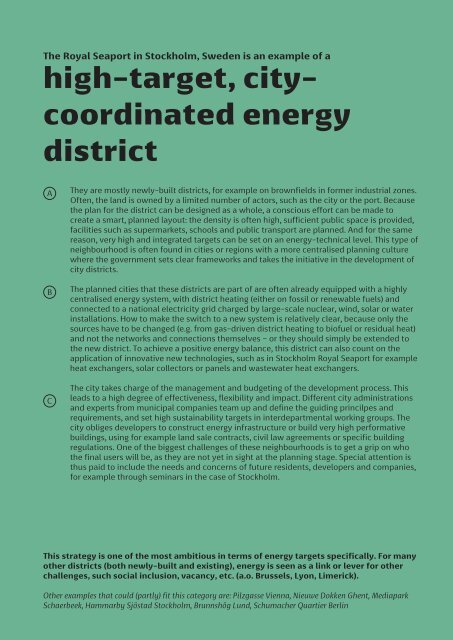Cities4PEDs Atlas_November 2021.pdf
Atlas - From 7 case interviews to recurring strategies and PED relevant aspects
Atlas - From 7 case interviews to recurring strategies and PED relevant aspects
- No tags were found...
You also want an ePaper? Increase the reach of your titles
YUMPU automatically turns print PDFs into web optimized ePapers that Google loves.
The Royal Seaport in Stockholm, Sweden is an example of a<br />
high-target, citycoordinated<br />
energy<br />
district<br />
A<br />
B<br />
C<br />
They are mostly newly-built districts, for example on brownfields in former industrial zones.<br />
Often, the land is owned by a limited number of actors, such as the city or the port. Because<br />
the plan for the district can be designed as a whole, a conscious effort can be made to<br />
create a smart, planned layout: the density is often high, sufficient public space is provided,<br />
facilities such as supermarkets, schools and public transport are planned. And for the same<br />
reason, very high and integrated targets can be set on an energy-technical level. This type of<br />
neighbourhood is often found in cities or regions with a more centralised planning culture<br />
where the government sets clear frameworks and takes the initiative in the development of<br />
city districts.<br />
The planned cities that these districts are part of are often already equipped with a highly<br />
centralised energy system, with district heating (either on fossil or renewable fuels) and<br />
connected to a national electricity grid charged by large-scale nuclear, wind, solar or water<br />
installations. How to make the switch to a new system is relatively clear, because only the<br />
sources have to be changed (e.g. from gas-driven district heating to biofuel or residual heat)<br />
and not the networks and connections themselves – or they should simply be extended to<br />
the new district. To achieve a positive energy balance, this district can also count on the<br />
application of innovative new technologies, such as in Stockholm Royal Seaport for example<br />
heat exchangers, solar collectors or panels and wastewater heat exchangers.<br />
The city takes charge of the management and budgeting of the development process. This<br />
leads to a high degree of effectiveness, flexibility and impact. Different city administrations<br />
and experts from municipal companies team up and define the guiding princilpes and<br />
requirements, and set high sustainability targets in interdepartmental working groups. The<br />
city obliges developers to construct energy infrastructure or build very high performative<br />
buildings, using for example land sale contracts, civil law agreements or specific building<br />
regulations. One of the biggest challenges of these neighbourhoods is to get a grip on who<br />
the final users will be, as they are not yet in sight at the planning stage. Special attention is<br />
thus paid to include the needs and concerns of future residents, developers and companies,<br />
for example through seminars in the case of Stockholm.<br />
Working document<br />
This strategy is one of the most ambitious in terms of energy targets specifically. For many<br />
other districts (both newly-built and existing), energy is seen as a link or lever for other<br />
challenges, such social inclusion, vacancy, etc. (a.o. Brussels, Lyon, Limerick).<br />
Other examples that could (partly) fit this category are: Pilzgasse Vienna, Nieuwe Dokken Ghent, Mediapark<br />
Schaerbeek, Hammarby Sjöstad Stockholm, Brunnshög Lund, Schumacher Quartier Berlin<br />
15


















